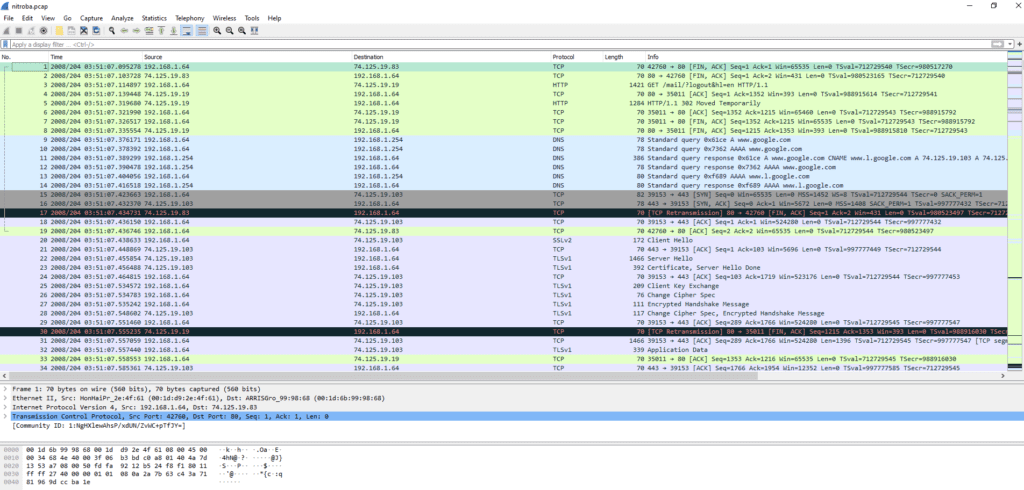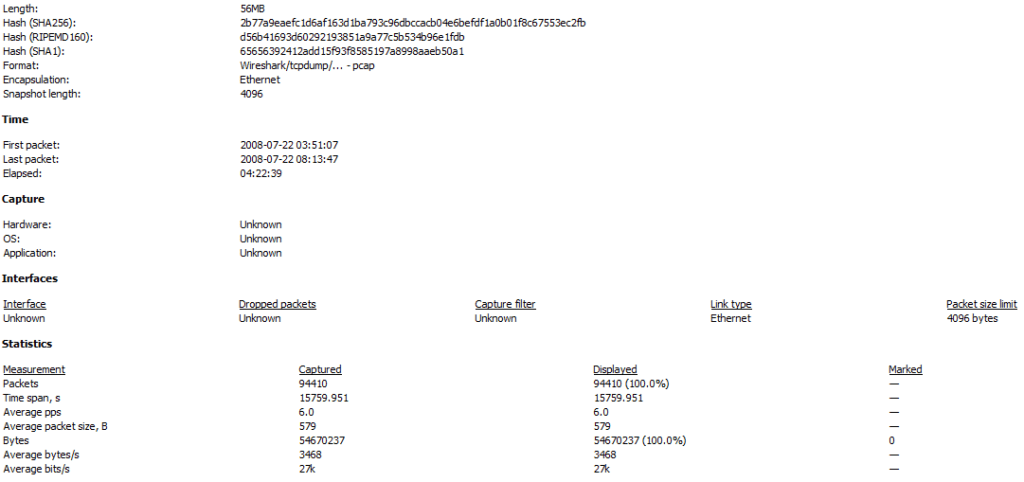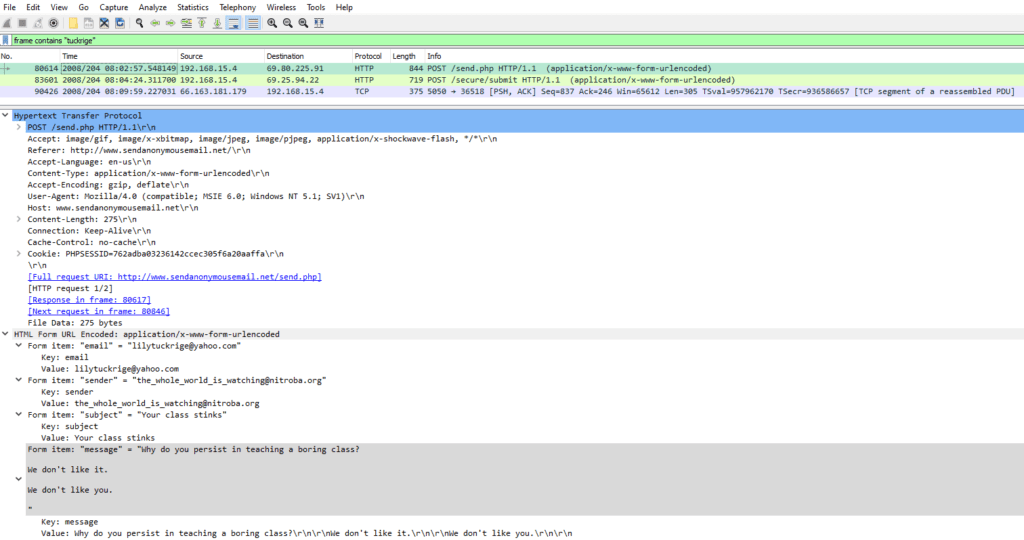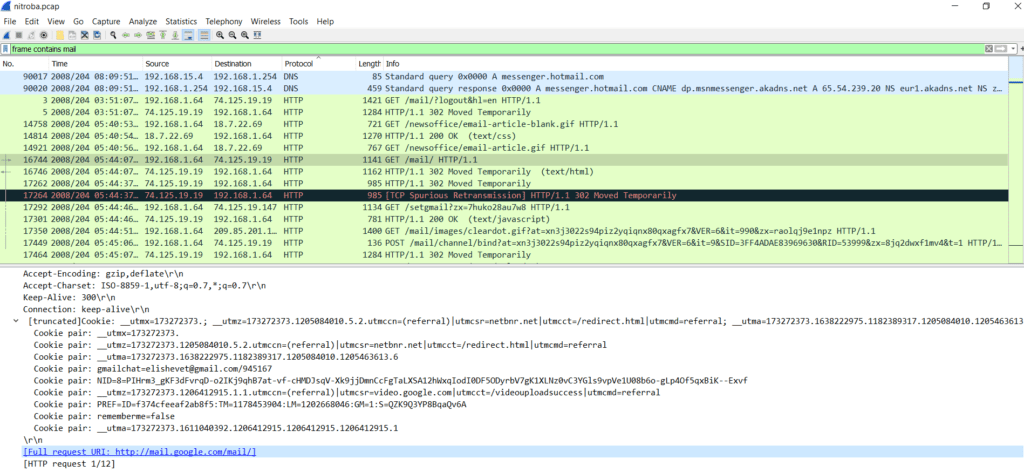In this article, I’m going to show you how to use Wireshark, the famous network packet sniffer, together with NetworkMiner, another very good tool, to perform some network forensics. You can easily download and install Wireshark here https://www.wireshark.org/download.html, on a Windows 10 machine for example, and NetworkMiner here https://weberblog.net/intro-to-networkminer/
I’m going to follow step by step a network forensics case, the Nitroba State University Harrassment Case. All the material is available here, published under the CC0 licence : https://digitalcorpora.org/corpora/scenarios/nitroba-university-harassment-scenario
This scenario includes two important documents
The first one is the presentation of the Case : http://downloads.digitalcorpora.org/corpora/network-packet-dumps/2008-nitroba/slides.ppt
The second one is the PCAP capture : http://downloads.digitalcorpora.org/corpora/network-packet-dumps/2008-nitroba/nitroba.pcap. Read below about PCAP

Let’s have a first look at the PCAP file
Just click on the PCAP file, and it should open in Wireshark. You get a first overview of the very long list of packets captured

In the first section, you get the list of packets/frames ordered by number, time, source IP, destination IP, protocol, length, and informations about content
In the second section, you see the details of a packet (here packet/frame number 1), shown according to the main layers of the OSI model. For packet number 1, we have informations about the first four layers (respectively n°1 “wire”, n°2 “Ethernet”, n°3 “IP”, n°4 “TCP”)

In the third section, we have the details of the packet number 1 in HEX format. It is usefull to check the source data in a “compact” format (instead of binary which would be very long)
As a very first step, you can easily gather statistics about this capture, just using the statistics module of Wireshark : Statistics => Capture File Properties

We can see that the SHA1 and SHA256 hash signatures match with the ones given in the scenario (as expected). We also see that the elapsed time of the capture was about 4 hours and 22 minutes. This is quite long, and explains the quantity of packets received in this network capture : 94 410 lines. No chance to read through each packet line by line…this is why a key concept in Wireshark is to make use of filters to narrow down any search made in the capture. As you can guess, we are going to use filters for our analysis…!
Map the Nitroba dorm room network

Now, read through the Powerpoint presentation to get an overview of the Case. There is one key information to start analyzing the PCAP capture

The IP was found in the email header

So, let’s filter the PCAP file using the IP adress used to send the first email : 140.247.62.34, both in the source and destination IP : ip.src==140.247.62.34 or ip.dst==140.247.62.34 (to learn the filtering by IP, check this : https://networkproguide.com/wireshark-filter-by-ip/)
We find that this IP has a low presence in the Wireshark statistics : 0.06% of the total sent packets (equal 52 packets)

Now, look closer at the IP adresses source and destination (here below a screenshot of the first packets)…you see that the IP 192.168.15.4 plays a central role as it is the only IP bridging with our IP 140.247.62.34

This type of IP is well known : it’s a private IP adress. See below some explanations


Let’s have a look in the OSI layer n°2 of a packet capture between these two IP adresses 192.168.15.4 (source) and IP 140.247.62.34 (destination). We find interesting informations about the hardware and MAC adress of the two physical devices pointed by these IP

So, the information reads as follows
| IP | MAC | Hardware |
| 192.168.15.4 (source) | 00:17:f2:e2:c0:ce | Apple |
| 140.247.62.34 (destination) | 00:1f:d9:2e:4f:60 | HonHaiPr |
A Google check with the MAC 00:17:f2:e2:c0:ce confirms this is an Apple device

What is HonHaiPr ? A carefull Google search reveals it’s Hon Hai Precision Industry Co Ltd, also known as the electronics giant Foxconn

Find who sent email to lilytuckrige@yahoo.com and identify the TCP connections that include the hostile message
Let’s use again the filter capabilities of Wireshark : frame contains “tuckrige”
We find three packets . The first two of them are using the OSI model layer n°7, that is the application layer, represented by the HTTP protocol. The last one is using the OSI model layer n°4, in this case the TCP protocol

The packet n°80614 shows an harassing message was sent using sendanonymousemail.net

The source IP is 192.168.15.4, and the destination IP is 69.80.225.91
The packet n°83601 shows an harassing message was sent using Willselfdestruct.com, with the exact email header as described in the Powerpoint “you can’t find us”

The source IP is 192.168.15.4, and the destination IP is 69.25.94.22
At this point of the article, we can confirm that the IP 192.168.15.4 plays a central role in the email “attacks” and the harassment faced by the professor Lily Tuckrige
Let’s keep in mind this key information for the next paragraphs
| IP | MAC | Hardware |
| 192.168.15.4 (source) | 00:17:f2:e2:c0:ce | Apple |
Find information in one of those TCP connections that identifies the attacker
So now that we have an interesting IP / MAC pair, that may lead to the identification of the attacker, what could we do next ?
I’ve decided to have a look further in the packets. Could we find maybe, the email adress of the attacker ? And, how to check that ?
I’ve just filtered in Wireshark typing “frame contains mail”. This is a little bit “quick and dirty” but could help to narrow down the research as I had no better idea at this point…then I went scrolling into the selected frames and found some frames titled “GET /mail/ HTTP/1.1 with some interesting content…look at the cookie ! They reveal some email adress and the link to the email platform used !
In the example below, we see the frame n°16744, showing a GET /mail/ HTTP/1.1, the MAC adress in layer 2 of the OSI model, and some cookie informations in clear text :
User-Agent: Mozilla/5.0 (Macintosh; U; PPC Mac OS X Mach-O; en-US; rv:1.8.1.16)
Cookie pair: gmailchat=elishevet@gmail.com/945167
[Full request URI: http://mail.google.com/mail/]

Of course, the http adress points to the Gmail sign in page. When the person is signing in, Gmail downloads the cookie for authentification needs

It’s quite amazing to find this level of information in clear text, furthermore in Wireshark, isn’t it ? Well, not quite. Just read this blog and the summary below -> enforce SSL so the cookie isn’t sent in cleartext !
https://blog.teamtreehouse.com/how-to-create-totally-secure-cookies

Now that we have found a way to identify the email adress of the attacker, let’s go through the different frames including the GET /mail/ HTTP/1.1 info and let’s check the email, IP, MAC data. Probably, we will find a match with the already suspicious IP/MAC pair from the previous paragraph ? Here below the result of my analysis in a table, the match is easily found and highlighted in red
| Frame | IP | MAC | |
| 16744 | elishevet@gmail.com | 192.168.1.64 | 00:1d:d9:2e:4f:61 |
| 78990 | jcoach@gmail.com | 192.168.15.4 | 00:17:f2:e2:c0:ce |
So who dit it ?
Now, we can come to a conclusion, since we have a potential name “jcoach”. Let’s compare with the list of alumni in Lily Tuckrige classroom

We have a match with Johnny Coach ! We found the solution to this harassment case 🙂
NetworkMiner versus Wireshark
As we solved the case with Wireshark, let’s have a quick look what NetworkMiner could bring. Here a good summary available in Google

I will provide here below a few screenshots of what you can do to solve the case



Conclusion
Doing this exercise, we have discovered some good network packet sniffers, and now could be able to solve more difficult cases
We have seen that with a good packet sniffer, a lot of critical informations could be collected…in such case your personal informations are no longer safe
It was pretty straigthforward to come down to the attacker, thanks to the available email header, then basic filtering in Wireshark and/or NetworkMiner, applying the necessary keywords
Is such a scenario realistic ? Yes, it could be. A network Admin can install such networking sniffers and gather data, or an attacker could slip in a network and also gather informations
To protect yourself, avoid the non encrypted protocols such as HTTP, FTP, TELNET
You can get additional informations about sniffing attacks here : https://www.greycampus.com/blog/information-security/what-is-a-sniffing-attack-and-how-can-you-defend-it
Update 2021/04/30 : please read the chat below, with the user “kinimod” as it shows a deeper complexity to the case !

Hi
Have you also been able to find Yahoo messenger authentication with the username “amy789smith” from the same IP and MAC address?
I think this can lead us to believe same computer could be used by multiple users.
Hi Kinimod, you could be right. In Wireshark, if you filter the frames with the keyword “amy789smith”, we can find the packet 90471, confirming a Yahoo messenger identification, and with the same IP/MAC as the one used by Johnny Coach
However, this IP/MAC is from the Apple router, not necessarily the one from the PC used to connect to this router. So, we cannot be 100% sure that Johnny Coach and Amy Smith logged in with the same PC
Hi, do you know if two MAC addresses, HonHaiPr_2e:4f:60 and HonHaiPr_2e:4f:61 are the same device, presumably that WiFi router that has been installed?
If yes I do not understand how can a logging machine behind that router see packets with the MAC addresses before the router?
Hi Kinimod, I can’t find HonHaiPr_2e:4f:61 in the PCAP file. A Google search shows that HonHaiPr_2e:4f:61 is also a factory default MAC address used by some Foxconn network switches
In my understanding, the WiFi router corresponds to the Apple MAC 00:17:f2:e2:c0:ce, as also shows the picture in the case introduction (page 6), which depicts an Apple device for the router. This page 6 also shows that multiple PCs and users are going through this router, this is consistent with your previous question
In addition, I believe the packet sniffer (=logging machine) is plugged into the network switch, as also shows the page 6 of the case. Such a packet sniffer will intercept any packets coming from the MAC address just before the network switch, so it will reveal our Apple device and traffic going through it. Your question is right, as the location of the logging machine in the network is crucial
If it may help you, here further informations : https://resources.infosecinstitute.com/topic/hacker-tools-sniffers/
Hi Forensicxs, HonHairPr MAC addresses are:
00:1d:d9:2e:4f:60
00:1d:d9:2e:4f:61
In regards to your second part, are you then saying that 00:17:f2:e2:c0:ce MAC address is of the Apple WiFi router from the photo and all the traffic from that router will be seen by the logging machine as coming from the 192.168.15.4 IP address ad 00:17:f2:e2:c0:ce MAC address (probably NAT-ing)? Taken into account there are other devices in 192.168.15.0 and 192.168.1.0 range, while also having Apple MAC addresses, we cant actually attribute the attack to a room or room area as it looks like logger is picking traffic from the whole switch and not just that rooms port?
I was actually thinking that the router was at the above two MAC addresses, …60 and …61, as they are sequential and have IP addresses in both ranges 192.168.15.0 and 192.168.1.0, however that wouldn’t make sense then as it would mean we can see a MAC address on the logging machine that is outside of the Layer 2 domain?
Hi Kinimod, I share your concerns as the network is not much documented, and therefore we need to trust the photo made available to us
Yes, I mean just that : “00:17:f2:e2:c0:ce MAC address is of the Apple WiFi router from the photo and all the traffic from that router will be seen by the logging machine”
We can identify the name of Johnny Coach, because he sent the harassing emails and we can trace back connections he made. We can then correlate this activity with the list of the classroom students
As Johnny Coach has been going through the Apple router, it is probable that he connected through one of the computers located in the room of Alice, Barbara, Candice. Beyond that, we can make hypothesis but cannot go further as the case provides limited informations
Hi Forensicxs
But would you alos say Amy Smith could have sent the emails, as her name also show in the packets. What makes you certain it is Johnny Coach?
Also instructions mention that WiFi router does not have a password, so technically could have been anyone in and around the room. Wouldn’t you agree?
Hi Kinimod, that’s really a couple of good questions 🙂 Thanks a lot for your value added !
Initially I had picked up Johnny Coach without a doubt, as its credential pops up easily in NetworkMiner
The timestamps provided help narrow down, although without absolute certainty
06:01:02 UTC (frame 78990) -> Johnny Coach logs in his Gmail account
06:02:57 UTC (frame 80614) -> first harassment email is sent
06:04:24 UTC (frame 83601) -> second harassment email is sent
06:09:59 UTC (frame 90471) -> Amy Smith logs in her Yahoo mail account
As Johnny Coach has been active just shortly before the harassement emails were sent, we could presume that he his the guilty one. To prove it 100%, we would need more forensics investigations (such as the hardware used / forensic image)
I agree that as the WiFi router is said to be not password protected, technically anyone could have been in and around the room, as you say
The case is quite theoretical and lacks informations, I think we are not required to make too complex hypothesis
I you find more clues, please share your thoughts 🙂
Hi Forensics
This was tremendously helpful, I honestly wasn’t even thinking of looking at the timelines of the emails.
Thanks for this will get back if I find anything else relevant.
Hello,
First of all, thank you for making me discover this mission.
In principle, all the students in the room use the Wifi router and therefore the only IP visible for the room at the sniffer is 192.168.15.4.
To distinguish the 3 PCs, we have to play on the users-agents. We end up finding this :
– Amy Smith : Mozilla/4.0 (compatible; MSIE 5.5)
– Ava Book : Mozilla/5.0 (Macintosh; U; Intel Mac OS X; en-US; rv:1.8.1.16)
– Jonny Coach : Mozilla/4.0 (compatible; MSIE 6.0; Windows NT 5.1; SV1)
What I learned from the 3 people:
Ava Book was mostly shopping on ebay (she was looking for a bag, maybe to store her laptop).
Amy Smith is not very present, she connects to yahoo messenger, where she changed her profile picture (TCP Stream of the 90468 frame and recovery of the picture), she has now a white cat on her head and pink hair 🙂
A priori, she has lilytuckrige as a friend on YMSG, we see it in frame 90426.
By looking at the frame 90471, we find an xml file p3p.xml containing Amy’s name and Ava’s name and email, I didn’t understand what this file was, do you have an idea ?
So Jonny Coach sent the malicious messages. He first sent an email, then did this google search: “send anonymous mail”, he then used the site he found to send the other email, then he googled “where do the cool kids go to play?” he listened to this song: The Cool Kids – “Black Mags”.
I don’t know if it’s possible to find an official solution?
See you soon
Hi o71, thanks for your message 🙂
Your analysis is good and supplements my article usefully
For the p3p.xml file, you may look here : https://en.wikipedia.org/wiki/P3P. It’s basically a retired privacy protocol
An official solution may have been asked directly on the Nitroba case website, but as there has been no recent comments on this page, I decided to write my “own” solution
Hi Forensicxs, can you please explain the part regarding “Now that we have found a way to identify the email adress of the attacker, let’s go through the different frames including the GET /mail/ HTTP/1.1 info and let’s check the email, IP, MAC data. Probably, we will find a match with the already suspicious IP/MAC pair from the previous paragraph ? Here below the result of my analysis in a table, the match is easily found and highlighted in red”
I have not understood what they have in common to prove that they are the same person.
Hi Lucas, thanks for your comment. elishevet@gmail.com and jcoach@gmail.com are not the same person, this is not my meaning here. I was explaining that I had found a way to catch emails associated to some IP/MAC data, and by carefully checking the PCAP records, I found the frame 78990 which helps narrow down to Johnny Coach. Please read the other comments in the chat, especially with “Kinimod”, as we can see that this exercise has some limitations.
Hope this helps !